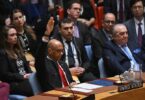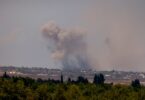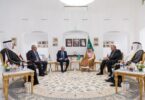EUGENE RUMER ANDREW S. WEISS
The West’s relationship with Russia is broken. Its policy toward Russia is broken, too. Today the United States, European Union, and Russia are locked into a mutual antagonism that, more than seven years since the pivotal moment of the Revolution of Dignity in Ukraine, has become the new status quo—an increasingly comfortable one for both sides. As President Joe Biden’s administration takes flight, the transatlantic community is faced once again with the challenge of forging a sustainable—and effective—common policy toward Russia.
However, notwithstanding the fact that they generally agree that Russia poses a serious threat, there are still significant differences between the United States and the EU on this issue. In Washington, by far the prevailing view is that the adversarial relationship with Russia is here for the long run and that it should be met head-on. By contrast, there are competing perceptions of how best to contend with a more assertive Russia among members of the EU, given their diverse historical legacies and geography and because European leaders already have their hands full dealing with other vexing problems.
This article argues that a realistic, “back to basics” approach to the Russia challenge is the best available option, but it will require certain compromises between the two sides of the transatlantic community. U.S. policymakers will have to accept that the EU’s relationship with Russia is bound to be substantially different from that of the United States and that there will always be a variety of views within the EU about its eastern neighbor. For their part, European policymakers will have to accept that the relationship with Russia is not going to get better in the foreseeable future, that it is a product of structural factors, and that the standoff with Russia is here to stay. The task before the transatlantic alliance, therefore, is to manage this relationship skillfully with resolve, responsibility, creativity, and an open mind.
DIFFERENT VISIONS
At the heart of the new standoff with Russia is a clash of two fundamentally different visions of European security. At the end of the Cold War, Western leaders put forth a vision for a Europe whole and free, united on the basis of shared values, without spheres of influence or other vestiges of the old order. That vision was codified in the Charter of Paris for a New Europe in 1990.
Russia signed the charter but its commitment to its spirit proved short-lived. For the Soviet elite the fall of the Soviet Union was a dramatic setback without a rational explanation, made all the more severe by the chaotic decade that followed it. No attempt to understand Russia’s relationship with the United States and the EU in the twenty-first century can succeed without taking into account its traumatic experience at the close of the twentieth century—one marked by military weakness and a stark contrast with the decade of stability, prosperity, geopolitical expansion, and boundless optimism enjoyed by most Western countries.
An unequivocal rejection by U.S. and European leaders of Russian claims to a special status and privileges in Europe was perceived in Russia as duplicitous. As seen from Moscow, some European countries were clearly more equal than others. There was no mistaking the “big three”—Germany, France, and Great Britain—for Portugal or Latvia in European political and security affairs. In the Kremlin’s view, Europe’s major powers had retained their special voices and vetoes in European affairs, but not Russia.
Stoked by a self-serving sense of grievance, Russian President Vladimir Putin successfully made the case to domestic audiences that this perceived double standard could not become the new status quo. The message of a historic injustice that fate dealt Russia, the country that more than any other was responsible for defeating fascism, resonated with Russian officialdom and the general public. It became the cornerstone of the new national narrative and of Putin’s foreign policy.
FIRST STEPS
The issues that lie at the heart of the rupture between the United States/EU and Russia are fundamental in nature. For the foreseeable future they cannot be bridged absent compromises that neither side is prepared to make. The sooner the United States and its European allies accept that the brief cooperative phase in relations in the late 1980s and early 1990s was an exception rather than the norm, the better their chances of coming up with a shared sustainable strategy for dealing with Russia. The notion that somehow Russia will address Western concerns by embracing sweeping changes to its domestic political order, or by replacing its well-established brand of foreign policy opportunism and calculated risk-taking with cooperation, is a form of magical thinking. The widespread belief held by many U.S. and EU officials that Russia is a declining power must not foster false comfort about its ability to present a meaningful threat.
For Biden, the immediate task is to repair the damage caused by four years of Donald Trump’s presidency with particular focus on overcoming the COVID-19 pandemic, putting the U.S. economy back on track, healing the country’s raw racial and political divisions, and tackling climate change. Throw in once-in-a-century challenges like the rise of China and sweeping technological change, and the new administration may quickly run out of bandwidth. Moreover, allocating scarce political capital to the standoff with Russia, for which there is no easy solution, would be decidedly shortsighted.
The Biden administration certainly will not ignore Russia. Top figures have already made clear that their strategy will prioritize closer U.S./EU coordination on pushing back against the Kremlin’s behavior and shoring up NATO’s military capabilities and the credibility of deterrence while leaving political space for cooperation on issues like arms control. More ambitious policy initiatives are also under development. To cite just one example, National Security Adviser Jake Sullivan has said that Biden intends “to rally our allies to combat corruption and kleptocracy, and to hold systems of authoritarian capitalism accountable for greater transparency and participation in a rules-based system.”
THE WAY AHEAD
NO SURPRISES, NO WEDGES
One of the oldest tricks in the Russian playbook is exploiting differences between the United States and its European allies. It is essential for both sides of the Atlantic to avoid self-defeating steps that play directly into Russia’s hands. At the same time, a single diplomatic and security strategy toward Russia is unlikely to be always feasible because of U.S.-EU differences that cannot simply be wished away. Therefore, close coordination among allies and partners will be essential to manage the transatlantic relationship and policy toward Russia.
Such differences are hardly insurmountable, and they can be minimized with astute and careful diplomacy. The theme for the next chapter in transatlantic policy toward Russia should be “no surprises, no wedges.” Regrettably, Western policy has been heavily reactive for a great many years. U.S. and European policymakers have struggled at times in their dealings with Moscow to set clear priorities, let alone to make a meaningful dent in its risk appetite. Getting off the back foot requires the United States and Europe to put a real price on behaviors that they find the most threatening and to think beyond merely countering Russia.
RETHINKING SANCTIONS
Nowhere are consultation and coordination more important than on the issue of sanctions. A first order of business for the Biden administration and its EU partners is to take a serious look at the efficacy of the diffuse strands of existing sanctions programs that were cobbled together over many years. Streamlining the entire effort as a tool for a broader diplomatic strategy and not as an end in itself also makes sense. So too does reasserting the U.S. executive branch’s overall leadership on sanctions policy. There is no longer a need to treat sanctions as a tool for tying the hands of a reckless (now former) U.S. president bent on doing favors for Putin or venting anger at the Kremlin’s unacceptable behavior.
The sanctions effort should once again be treated as a source of potential leverage for achieving specific aims such as finding a lasting political solution to the war in Ukraine or curtailing reckless Russian actions such as electoral interference, targeted killings, and cyber attacks. While U.S. and EU officials cannot expect that sanctions alone will solve these problems, they surely can be more systematic and judicious in subjecting such activities to public exposure and putting a specific price tag on the Kremlin’s misdeeds.
At the same time, the United States and its EU partners should not shy away from using precisely targeted sanctions against Russian officials and private individuals, as well as their family members and associates, who have been implicated in corrupt activities, rogue state behavior, and domestic political oppression. Those who subvert the rule of law and human rights in Russia and abroad should not be able to enjoy the benefits of free and law-abiding societies. While one should never overstate the potential influence of Russian elites over the Kremlin’s decisionmaking, travel bans, asset freezes, property seizures, and naming-and-shaming remain powerful punitive instruments.
BOLSTERING DETERRENCE AND DEFENSE
For all its bombast, the Trump administration was hardly original in pushing for a more equitable defense burden sharing between the United States and Europe. This issue has been a staple of the transatlantic conversation for decades. In this regard, NATO members need to take into account challenges facing the Biden team at home and the fact that the United States is now facing competition in two theaters—in Europe and in the Asia-Pacific. European countries are beginning to take on a greater defense burden and responsibility for sustaining the alliance’s defense and deterrence posture vis-à-vis Russia. The transatlantic conversation needs to shift from the simplistic focus on percentages of defense spending to the kinds of capabilities the alliance needs for the long haul while also recognizing that moves to strengthen deterrence can create a version of the classic security dilemma.
MANAGING THE MILITARY STANDOFF
For all the worries about it, the risk of a direct military confrontation with Russia appears fairly manageable. NATO has taken major strides by refocusing on its core mission of collective defense and bolstering deterrence. It has also done a great deal of work over the past seven years to make sure that the capabilities necessary for deterrence are credible and well-communicated to Russia. Moscow, of course, has a long track record of playing on fears of escalation and testing NATO resolve by staging provocations, whether in international waters and airspace or in Syria. Yet as of this writing, there are no indications that NATO states neighboring Russia are being directly militarily threatened or that the alliance will somehow shy away from operating in sensitive areas in the Baltic and Black Sea regions.
A two-track approach is warranted. On the one hand, robust confidence-building, transparency, and accident-avoidance proposals should be on the table for Russia to engage on. On the other hand, such proposals should be accompanied by a clear message that the West knows Russia’s provocative activities are part of a deliberate policy of intimidation and potential accidents. Meaningful progress in this area, which could include steps by NATO to address Russia’s concerns about allies’ activities near its border, is possible only when these activities stop.
CHALLENGES FOR THE EU
The EU’s relations with Russia have been in a downward spiral following the failed assassination attempt against Russian opposition leader Alexei Navalny in August 2020. Instead of owning up to the misdeeds of its security services, the Kremlin has opted for a combination of bluster and wild accusations that it apparently hopes will confuse domestic audiences and prompt European leaders to move on. Yet Russian harangues aimed at German and French leaders, along with the deliberate snub of EU High Representative for Foreign Affairs Josep Borrell during his visit to Moscow in February, have backfired. Instead of bolstering the voices of those in the transatlantic community who might advocate for a more balanced strategy, the Kremlin simply pulled the rug out from under them.
Such moves compound problems stemming from the Kremlin’s failure to appreciate how the European Union actually operates and long-standing desire to deal bilaterally with EU member states. In the meantime, the preferred framework of Baltic and Central European countries—a policy that, as one astute European analyst puts it, “seeks to influence Russia through criticism . . . emphasizes conditionality, treats dialogue as a reward, and resorts to symbolic acts”—is likely to form the bedrock of the EU’s approach.
Germany’s search for middle ground is becoming harder to sustain. German Chancellor Angela Merkel has consistently pressed for a combination of EU unity on sanctions and coordinated, EU-led responses to Russian misdeeds while pursuing various forms of dialogue and cooperation in the commercial and energy fields. It is not yet clear whether her approach will prevail following federal elections later this autumn and the expected hand-off to a new chancellor and a possible new coalition government. German policy toward Russia may end up being pulled in several different directions with some in the leadership advocating a tougher line, and others trying to protect the space for dialogue as well as German business interests. Finding the right balance will be more difficult in the absence of Merkel’s stature and experience. In the meantime, the bad news will continue to pile up (for example, negotiations with Washington over the fate of the controversial Nord Stream 2 natural gas pipeline, investigation of the 2015 GRU cyber attack on the Bundestag, and the trial of the gunman accused of killing a Chechen exile in central Berlin in 2019).
INF REDUX
The Biden administration’s decision to extend New START for a full five years has given rise to hopes that a new era of more intensive arms control discussions with Moscow may lie ahead. There are plenty of reasons for healthy skepticism on that score, which lie beyond the scope of this article.
Following the demise of the Intermediate-Range Nuclear Forces (INF) Treaty in 2019, the United States is on track to acquire previously banned land-based cruise and ballistic missiles. Whether, how, and where they may be deployed has not been decided, but the possibility of their deployment in Europe is certain to be highly controversial within the alliance. Meanwhile, Russia has recently proposed a moratorium on deployment of INF-range missiles in Europe including redeploying its 9M729 missile, which the United States and its allies maintain violates the INF Treaty, away from European Russia to Asia. This is well short of repairing the damage caused by its earlier violation of the INF Treaty and potentially threatens the security of U.S. treaty ally and G7 partner Japan. However, engaging with Russia to explore its thinking on the moratorium and the possibility for progress toward arrangements to mitigate the damage from the demise of the INF Treaty is warranted, especially since neither the United States alone nor NATO as an alliance has reached a decision on deploying INF-range missiles in response to the Russian violation.
For the Biden administration it is important to recognize that the INF Treaty did not affect the physical security of the continental United States, while the security of Europe was at stake even though no European nation was a party to the treaty. The United States will have to coordinate early and closely its actions in response to the Russian violation with its allies, just as it did on reaching a full consensus among the allies on the violation itself. Discord within the alliance on this issue would be fraught with dire consequences. A new INF Treaty is highly unlikely for reasons well beyond the scope of this article, but an arrangement based on mutual restraint and transparency with Russia that could also address the Russian concern about the MK-41 launchers deployed by the United States in Europe as part of the Aegis Ashore missile defense system may serve as a meaningful substitute.
CURBING ROGUE BEHAVIOR
Russia has embraced malign activities as a tool to undermine Western societies and to seek short-term advantage. Without diminishing or dismissing the harmful effects of Russian activities, it is important to recognize that the Kremlin embraces them precisely because it knows that it cannot compete head-to-head in conventional military terms. Nor is Russia responsible for maladies such as polarization, societal mistrust, and populism that currently afflict Western societies. Of course, it is also clear that frequent Russian efforts to undermine trust in Western electoral democracy and brazen cyber attacks have proven hard, if not impossible, to deter.
The most effective way to respond is a long-term strategy that puts a spotlight on such attacks while working to address the root causes in Western societies that these attacks seek to exploit and shore up their resilience. The United States and Europe are already pooling considerable resources and coordinating strategies on issues such as unmasking and countering Russian subversion and disinformation. This is, in some ways, a thankless task. But there are few practical alternatives to marshalling the governmental, legislative, and regulatory measures necessary for hardening Western societies against ills such as disinformation, illicit financial flows, old-fashioned espionage and criminality, and powerful new cyber tools. The United States and Europe may not be able to sanction or browbeat their way out of this problem, but they can learn to cooperate in more far-reaching ways.
REDISCOVERING UKRAINE
Ending four years of malign neglect of Ukraine in the Oval Office is a no-brainer. The problems facing Ukraine, one of the poorest yet most strategically important countries in Europe, are daunting. They are made worse by the country’s deeply entrenched corruption, state capture by well-placed insiders and oligarchs, and a culture of impunity. Tackling such problems, in addition to dealing with the unresolved conflict in Donbas, will require a renewed high-level U.S.-EU diplomatic commitment of time and attention.
Unfortunately, the willingness and ability of the government of President Volodymyr Zelensky to act boldly on overdue reforms or the Donbas conflict have shrunk dramatically. As his popularity and Ukrainians’ living standards have slumped, Ukraine has become a more difficult partner to the West, which of course delights the Kremlin. Even though Zelensky has raised eyebrows by toying publicly with the possibility of renouncing the Minsk Accords, it is hard to identify viable alternatives to this framework. Thankfully, the level of violence along the line of contact has stayed relatively subdued since last July. Further Western support for the modernization of Ukraine’s defense and national security capabilities can help maintain the status quo in the conflict zone and reduce the temptation for Russia to pursue its objectives by military means. Although work on the diplomatic track is effectively frozen due to stalling by Moscow, a unified U.S./German/French political dialogue with the Kremlin remains essential as is a stern response to Putin’s recent insistence that Russia “will never abandon Donbas no matter what.”
Putting Ukraine’s stalled domestic transformation back on track also requires a long-term commitment of U.S. and European support. Partners on both sides of the Atlantic are understandably frustrated that the current leadership in Kyiv has struggled to make much headway on ambitious political and economic reforms. They must continue demanding meaningful action as well as a credible fight against corruption. Nor is there any effective substitute for the traditional formula of tough love and conditionality, alongside Ukrainian civil society. Closer U.S.-EU coordination, backed by the international financial institutions, may not always pay immediate dividends, but it is the only pathway for ensuring the eventual emergence of a stable, secure, and prosperous Ukraine.
BEING CLEAR-EYED ABOUT RUSSIAN DOMESTIC POLITICS
The Kremlin’s relentless mistreatment of Alexei Navalny and the rise of a new street protest movement have put Russian domestic politics and human rights issues squarely back on the transatlantic agenda. The Biden administration appears determined to hold Russia accountable but wisely does not wish to rule out forms of cooperation that still make sense. Moscow’s strategy is straightforward: to crack down just hard enough to deter unsanctioned political activity while rejecting foreign criticism as a form of interference in its domestic affairs and portraying protesters and opposition figures as tools of Western intelligence agencies. This strategy has proven effective in previous periods, and U.S. and EU officials must operate carefully to avoid sending any message to the people of Russia that the West’s leaders are just as cynical as their own political establishment. While the United States and some EU member states have plenty of work to do to strengthen democracy at home, the Kremlin should not be given a pass.
The United States and Europe should be braced for a challenging situation that could endure for many years. The Kremlin’s ongoing assault on civil society and human rights in Russia has been building over the past two decades. It will likely remain a source of fundamental disagreement and a violation of Russia’s commitments under the Helsinki Charter, just as it was in Soviet times. It is a mistake to assume that the West can successfully play favorites inside Russian society or engage in full-scale democracy promotion activities without potentially endangering Russian activists or alienating the Russian public. One way to bridge the gap in these two positions could be to focus more effectively on reducing exposure to Russia-generated corruption and illicit financial flows, as well as taking steps to penalize Russian establishment figures involved in violations of human and civil rights.
It is also necessary to think more about possible alternative trajectories for Russia’s domestic development. However tempting as it may be to think that generational change in Russia will automatically play in the West’s favor, one needs to be clear-eyed about Russia’s demography (only 9.5 percent of the population is aged fifteen to twenty-four) and the fact that the intense rupture between the two sides is unlikely to fade once Russia’s current leaders begin to step back from power.
IRAN
The issue of Iran’s nuclear program will be a key litmus test of the West’s ability to reengage in productive fashion with Russia since both are interested in returning Iran to compliance with the Joint Comprehensive Plan of Action (JCPOA). Assuming that the deal can be resuscitated (which is by no means assured), there is an important potential role for Russia to play in removing Iran’s growing stockpile of fissile material in exchange for providing other forms of support for peaceful nuclear energy activities. But, while a renewed JCPOA could be one of just a handful of bright spots on the U.S.-Europe-Russia agenda, this would not necessarily create positive spillover for other aspects of their relationship.
CLIMATE AND ENERGY
Sustained, high-level engagement with Russia on climate change is also overdue. Unfortunately, Putin and other senior figures in Moscow have long resisted such discussions, insisting that a warmer climate is a blessing that will benefit the country’s economic development. The Kremlin remains captivated by the prospect of expanding commercial farming or opening new northern shipping routes to deliver liquefied natural gas (LNG) and other lucrative cargos to markets in Asia. Russia’s scientific establishment has tried—without success—to challenge such arguments.
It is hard to imagine breaking the inextricable connection between power and money in Russia, which clouds its leadership’s ability to come to grips with extremely negative impacts of climate change that are already visible. These include the ongoing release of CO2 and methane as permafrost melts in parts of the Arctic, the destruction of forested regions in Siberia due to insect infestations, the devastating flooding unleashed by new hydrological conditions, and other well-documented problems. Russian businesses and communities in affected regions are experiencing major industrial accidents and coping with the loss of infrastructure and ice roads that make working conditions far more unstable.
Russia’s energy industry is likely to face a more complex landscape as large parts of Europe, Asia, and North America accelerate their transition to a zero-carbon future. For example, energy consumers in Europe are rejecting purchases of LNG sourced from regions, such as the United States’ Permian basin, that do not deal properly with the negative climate impacts of energy exploration. Russia’s oil and gas industry would be particularly vulnerable to such scrutiny, given its long-standing embrace of harmful practices such as large-scale gas flaring and emission of methane. (Methane is far more harmful than CO2 in terms of its climate warming potential.) Despite the Russian leadership’s denialism, an updated version of Leon Trotsky’s famous adage rings true: “Russia may not be interested in climate change, but climate change is interested in Russia.”
CONCLUSION
It will take compromise and accommodation on both sides of the Atlantic to translate even a “back to basics” agenda with Russia into reality. For the Biden administration, it will be essential to recognize that the United States and Europe have different stakes in their respective relationships with Russia. For the United States, it is not always clear whether Russia is a perennial source of existential threat or a nuisance. For Europe, Russia poses a threat but it is also the biggest neighbor with which there is a long history of ups and downs as well as an important trading partner and target for investments. Managing these different perspectives will be key to a successful transatlantic strategy toward Russia.
The policy ideas outlined in this article do not preclude engagement with Russia on issues of critical importance such as arms control and strategic stability. It is uncontroversial to leave the door open to substantive, sustained dialogue in virtually all areas of disagreement. This will be essential for managing these disagreements and should not be considered a reward for Russia’s bad behavior. Nor should it be viewed as a concession by the West to Russia or as a form of engagement for engagement’s sake. Still, the quality of the dialogue will be an important indicator of Russia’s sincerity and willingness to manage its differences with the West.
Finally, it is important for Western policymakers to recognize that their record of predicting Russia’s future is poor. The history of the country’s relations with the West inspires more pessimism and caution than optimism and boldness in dealing with it. The long-term nature of the Russia problem demands that Western policymakers approach it with steadfastness, unity, and solid risk management.
This article was produced with generous financial support from the German Federal Foreign Office and in cooperation with the Friedrich Ebert Stiftung (FES). The authors are grateful to the FES’s Reinhard Krumm and Peer Teschendorf for their very useful inputs. The authors also benefited from two FES-hosted workshops conducted via Zoom in late 2020 with current and former European and U.S. officials and scholars. Any errors in facts or judgment are solely those of the authors.
Courtesy: (carnegieendowment.org)






